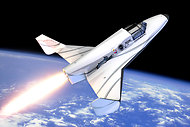 | ||
| Lynn's at the laptop managing software that determines what is shown on the globe in the background. |
The science lessons taught through the set-up are all based on data gathered by NASA satellites. These satellites have been recording information about our planet as well as other planets and celestial bodies for decades. As the data accumulates, it's possible to begin to see patterns of change over time.
Want to see how the levels of chlorophyll change on Earth over the course of the last several years? How about changes in ice pack as seasons come and go? Interested in changes in gas densities on Saturn? Or magnetic changes on Mercury? Given the accumulated data, the possibilities for inquiry are virtually limitless. As Teri said to me, "I'd love to create a course solely based on analyzing the data sets."
What makes the data come alive is the hardware. The data is put through a software tool that allows it to be projected on to a sphere. In the photo above, the "Earth" is actually a translucent ball (about the size of beach ball), sitting atop a projector. The specially designed projector acts as a podium stand for the ball and also, through a series of mirrors, is able to project images on to the sphere. These images can then be set in motion, so the Earth, or any other planet, will spin. Students see a reasonable replica of a planet, spinning on its axis, illustrating wind, temperature or electron-magnetic changes, to give some examples.
Below, a few more shots of the globe as it projects images from our solar system. The globe has not changed; the software controlling the projection is creating the image of the Sun, the Earth and Jupiter.
The class I observed was a group of Sue Hone's third graders. Their analytical skills were sharpened by a series of directed questions based on what they were seeing. They were at first intrigued and then quickly were quite engaged in the lesson. Here's a few shots of the young scientists hard at work:
Though I did not get a chance to see a Middle School class, I did speak with Teri after her lessons. Teri went through a full week of training at the Liberty Science Center over the summer to be fully ready to utilize the software to the fullest. Though Lynn's preparation was not quite as extensive, both emphasized that the software was quite full-featured and training was necessary to make the most of the data NASA provides. That said, I was still interested enough to check out the the web site, NASA Earth Observations, that houses the satellites' earth data. It's definitely worth some "exploration time."
By the time you read this the equipment will be gone from campus, but Teri tells me she's already reserved it for two weeks in December and two weeks in March. If you are interested, it would be worth your while to find a way to see a demonstration.
Want to see how it all looked the day I visited class? Just click on Science in the Classroom.





